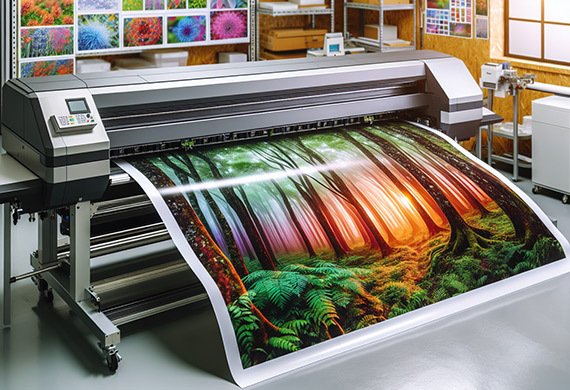Eco Solvent Printing
Posted by Clash Printing Atlanta on 20th Mar 2024
Are you wondering what eco-solvent printing is and why it's beneficial for your projects? Solvent printing is a powerful digital printing method that uses solvent-based inks to deliver vibrant, long-lasting prints on various materials. Ideal for outdoor applications and large-format displays, solvent printing stands out for its durability, color intensity, and cost-effectiveness. Continue reading to uncover this versatile printing technology's complexities, advantages, and practical applications.

Key Eco-Solvent Printing Takeaways
- Solvent printing is a versatile, durable, and cost-effective printing method that utilizes organic solvent-based inks to produce vibrant and weather-resistant graphics suitable for large-scale outdoor applications such as billboards, vehicle wraps, and banners.
- Different types of solvent inks, including hard solvent, mild solvent, and eco-solvent, offer varying degrees of durability and environmental impact. Eco-solvent inks provide high-resolution prints with a lower ecological footprint despite slower drying times and higher costs.
- While solvent printing boasts several advantages, like large-format capabilities and economic efficiency, it also faces challenges, such as environmental concerns due to the release of volatile organic compounds, safety considerations for workers exposed to fumes, and material limitations for sensitive substrates.
Understanding Solvent Printing
Solvent printing is not just a process; it's an art form that transforms the mundane into the magnificent. Imagine a printing technique so versatile it can cover buildings with stunning murals or vehicles with eye-catching advertisements. This is the realm of solvent printing, where inkjet plotters wield the power of pigment solvent ink, embracing organic solvents to create prints that defy the elements and stand the test of time. It's a world where the vibrancy of colors and the durability of prints come together in a symphony of visual delight.
This printing technology replaces traditional aqueous ink with organic solvent-based alternatives, catering perfectly to those who demand excellence on a grand scale. Where traditional printing methods fall short, solvent printing steps in, offering a cost-effective and durable solution for various projects; whether it's a billboard under the scorching sun or a banner braving a blizzard, solvent prints rise to the occasion, delivering high-quality prints with unparalleled resilience.
Types of Eco Solvent Inks
Within the domain of solvent printing, the inks are the unsung heroes, each with unique characteristics and strengths. Step into the diverse world of solvent inks. There's a spectrum of options, including:
- Hard solvent inks: the titans of durability, holding firm against the fiercest weather
- Mild solvent inks: balancing strength with a gentler environmental footprint
- Eco-solvent inks are the green warriors of the ink world. They boast biodegradable solvents and a softer scent that makes them a favorite for indoor sanctuaries.
However, the choices don't come without trade-offs. Despite their ecological and functional allure, Eco-solvent inks ask for patience with slower drying times and a higher price tag, a small price to pay for their high-resolution prowess. On the other hand, traditional solvent inks offer a cost-effective solution but may not reach the dizzying heights of over 1000 dpi that eco-solvent inks proudly claim. But no matter the type, solvent inks have carved a niche in the printing world, providing options for every need and application.
Advantages of Solvent Printing
The variety of benefits from solvent printing matches the diversity of its prints. From the robustness that braves the elements to the grandeur of large formats, this printing method is a beacon of versatility and cost-efficiency. This method is transformative for those seeking to make a lasting impression without breaking the bank.
Weather-Resistant Prints

Imagine a banner that survives the harshest winters or a vehicle wrap that endures the relentless summer sun. Solvent prints are like a knight's armor, resilient in the face of environmental onslaughts. The solvent ink doesn't merely sit atop the material; it etches into it, creating a bond that's as durable as it is. Whether it's hard solvent inks ensuring that graphics on uncoated vinyl live on without a peel or mild solvents proving their mettle with fewer VOCs, the durability is unmistakable.
When it comes to extending this invincible lifespan even further, lamination steps up as the loyal sidekick. This dynamic duo of solvent print and protective lamination ensures that colors remain vibrant and surfaces remain unscathed, even when nature throws its worst at them. Eco-solvent prints join the fray, with scratch resistance and fade defiance contributing to their growing popularity. It's clear that when it comes to weathering the storm, solvent prints are the steadfast choice.
Large Format Applications
The scale of solvent printing's capabilities is nothing short of extraordinary. Picture materials sprawling up to 5 meters wide, begging to be adorned with colorful, impactful graphics. This is where solvent printing truly shines, handling an impressive array of outdoor and flexible media with ease. From the ruggedness of PVC Flex banners to the elegance of an artist's canvas, solvent printers embrace them all.
The applications of solvent printing are as broad as the materials themselves. Some examples include:
- Corridor lightboxes
- Subway station displays
- Detailed wallpapers
- Static clings
- Truck tarpaulin advertising
Solvent printing is known for its versatility and ability to maintain details and static charge. In the world of large-format printing, solvent technology reigns supreme, bringing visions to life on a grand scale.

Cost Savings
The allure of solvent printing isn't just in its vibrant prints or expansive applications but also in the wallet-friendly advantages it brings. Imagine slashing your printing costs significantly without compromising quality; this is the reality with solvent inks. By eliminating the need for inkjet-receptive coatings on most substrates, material costs plummet, making solvent printing a beacon of economic efficiency.
Eco-solvent printers and inkjet printers offer several benefits, including eco-solvent printing:
- Using less energy and producing less waste, resulting in environmental savings
- Improved ink retention and reduced equipment wear, leading to long-term cost savings
- An attractive option for businesses looking to maximize their return on investment with an eco-solvent printer
Disadvantages of Solvent Printing
Yet, like all technologies, solvent printing has its Achilles' heel. Behind the vibrant prints and cost-saving measures lie challenges that include environmental concerns, safety considerations, and material incompatibilities.
This powerful printing method serves as a reminder of the need for care and responsibility in its use.
Environmental Impact
The shadow cast by solvent printing is evident in its environmental impact. The inks, particularly traditional hard solvent varieties, release volatile organic compounds that contribute to air pollution and the formation of ground-level ozone. These chemicals, like cyclohexanol found in abundance in hard solvents, pose significant environmental hazards, pushing the industry towards milder alternatives with a softer touch on nature.

Water pollution is another grim reality, as runoff from the printing process can carry toxic substances into our waterways, threatening aquatic ecosystems. While mild solvent inks present a lesser threat due to reduced cyclohexanol content, the quest for more environmentally friendly printing practices, including water-based ink and less ink, remains a pressing issue. Balancing the demands of the industry with planetary health is a complex task.
Safety Considerations
The fumes from solvent printing are not to be taken lightly. Workers exposed to the potent odors of oil-based inks laden with VOCs face risks to their respiratory health and well-being. Safety in the workplace becomes paramount, with the following measures being essential for mitigating these risks:
- Adequate ventilation systems
- Regular monitoring of air quality
- Use of personal protective equipment (e.g., masks)
- Training on proper handling and disposal of solvents
Employers can implement these measures to ensure the safety and well-being of their workers in a solvent printing environment.
The potent nature of solvent inks demands that safety measures be more than an afterthought. Ensuring that printing facilities are equipped to handle the output of these inks is not just a matter of compliance but a commitment to the health of those on the front lines of printing. The evolution of the printing industry necessitates the advancement of safeguards that protect its artisans and address their printing needs.
Material Limitations
Solvent printing's versatility does not extend to all materials. As the inks interact with various surfaces, some sensitive to harsh chemicals may suffer damage. This limitation necessitates careful selection of substrates, ensuring compatibility and preserving the integrity of the prints.
Textiles, in particular, present a unique challenge. While solvent inks can be used on fabric, the resulting stiffness and discomfort limit their application in the apparel industry. Finding the perfect substrate is crucial in the solvent printing process to meet the dual demands of quality and comfort.
Comparing Solvent Printing Technologies
Solvent printing stands tall among its peers but is not without competition. UV-curable inks and dye sublimation are two contenders that offer their distinct advantages and realms of application. While solvent printing boasts versatility and no limitations on print run length, UV printing shines with its instant drying and broad substrate range, including materials like glass and metal. The initial investment may be higher for UV, but the operational economies can be compelling over time.
Dye sublimation, on the other hand, is the darling of the textile industry. Its ability to infuse fabric fibers with color creates prints that are not only beautiful but also comfortable and durable, perfect for the world of fashion. Each technology has carved out its niche, with solvent printing remaining a steadfast choice for those seeking high-impact, large-format prints.
Choosing the Right Solvent Printer
Choosing a solvent printer requires thoughtful consideration. Speed and resolution are the drumbeats to which high-quality prints march, dictating vibrancy and detail. Large-format print needs are best served by printers that can keep pace with demand without sacrificing quality.
Connectivity options, cost-effectiveness, and brand reputation round out the checklist for potential buyers. A printer that ticks all these boxes, coupled with a supportive manufacturer known for durability and customer service, can make all the difference in the printing experience. Ultimately, the right solvent printer is not just a purchase; it's a partnership in print.
Tips for Successful Solvent Printing
Successful solvent printing hinges on attention to detail. A dust-free environment, for instance, is the foundation of optimal print performance, protecting against contaminants that can mar the final product. Maintaining a stable humidity level in the print room is equally crucial, as well as preserving print quality and minimizing the need for frequent maintenance.
Regular maintenance routines for a solvent printer include:
- Agitating ink cartridges
- Performing firmware updates
- Using manufacturer-approved inks and materials
- Running the printer regularly
- Protecting the CPU from electrical surges
By embracing these practices, your solvent printer will reward you with prints that stand the test of time, just like those produced by traditional printers.
Real-Life Applications of Solvent Printing

The footprints of solvent printing are everywhere, from the bustling avenues of advertising to the textured world of fabric printing. Its ability to produce large-format prints with stunning visual impact makes it the go-to for PVC banners, window films, and even cotton fabric applications. Solvent printing's versatility has made it a staple in high-impact visual communications, capable of turning heads and captivating audiences.
The applications of solvent printing span from amateur projects to professional-grade productions, reflecting the diversity of the prints. It's a testament to the technology's adaptability and effectiveness in conveying messages, branding, and art across a multitude of platforms and materials. In the hands of a skilled printer, solvent printing becomes a powerful tool for:
- Visual storytelling
- Advertising
- Marketing
- Creating signage
- Producing high-quality prints
Solvent Printing Summary
As we wrap up solvent printing and all it entails, let's reflect on the vibrant colors and high-quality prints that have become synonymous with this technology. Its ability to produce durable, large-format prints at cost-effective rates has cemented its place in the printing industry. Despite some challenges, the evolution of eco-solvent inks and advancements in safety and material compatibility continues to shape its future. As an indomitable force in printing, solvent printing remains a pivotal player, fueling creators' and businesses' imaginations and marketing strategies.
Frequently Asked Questions
These are the most frequent eco-solvent printer questions:
What is a solvent print?
Solvent print is a printing process that uses ink made from petroleum-based products like acetone. It allows it to print onto surfaces like vinyl, metal, PVC, and fabric and is waterproof when dry.
What is the difference between UV print and solvent print?
The main difference between UV printing and solvent printing lies in the technology used and the type of ink. UV printing utilizes ultraviolet curing technology and light to print. In contrast, solvent printing uses solvent-based technology to create liquid ink that evaporates to leave a hard layer of ink.
What is the difference between solvent and inkjet printers?
Solvent printers use solvent inks and work well with materials like vinyl, while inkjet printers typically use aqueous inks and are best for printing on paper. Wide format printers are suitable for large prints, with capacities over 100 inches considered super-wide or grand format. These printers are typically used for pigmented fine art inkjet printing.
What is an eco-solvent printer?
An eco-solvent printer uses special inks to create high-quality, vibrant images while being environmentally friendly. This technology has revolutionized the production of durable and long-lasting graphics.
Can solvent printing be used for indoor applications?
Yes, solvent printing can be used indoors, especially with eco-solvent inks with lower odor and biodegradable solvents.
(678) 235-3464






